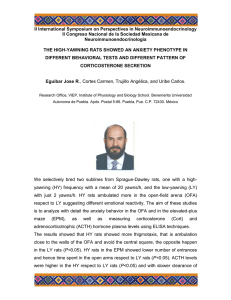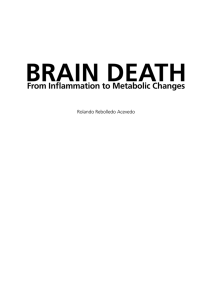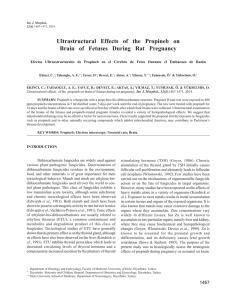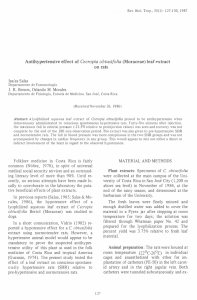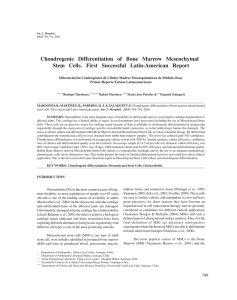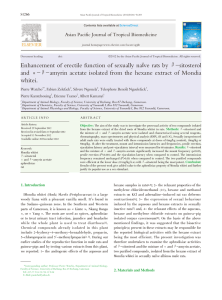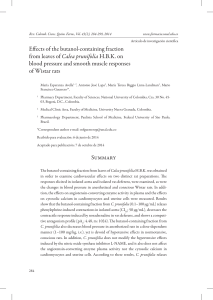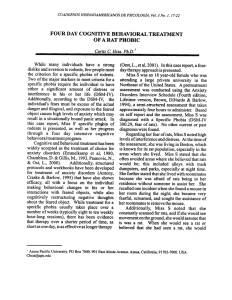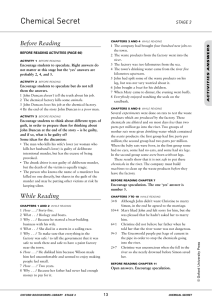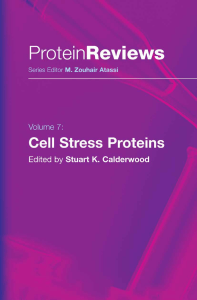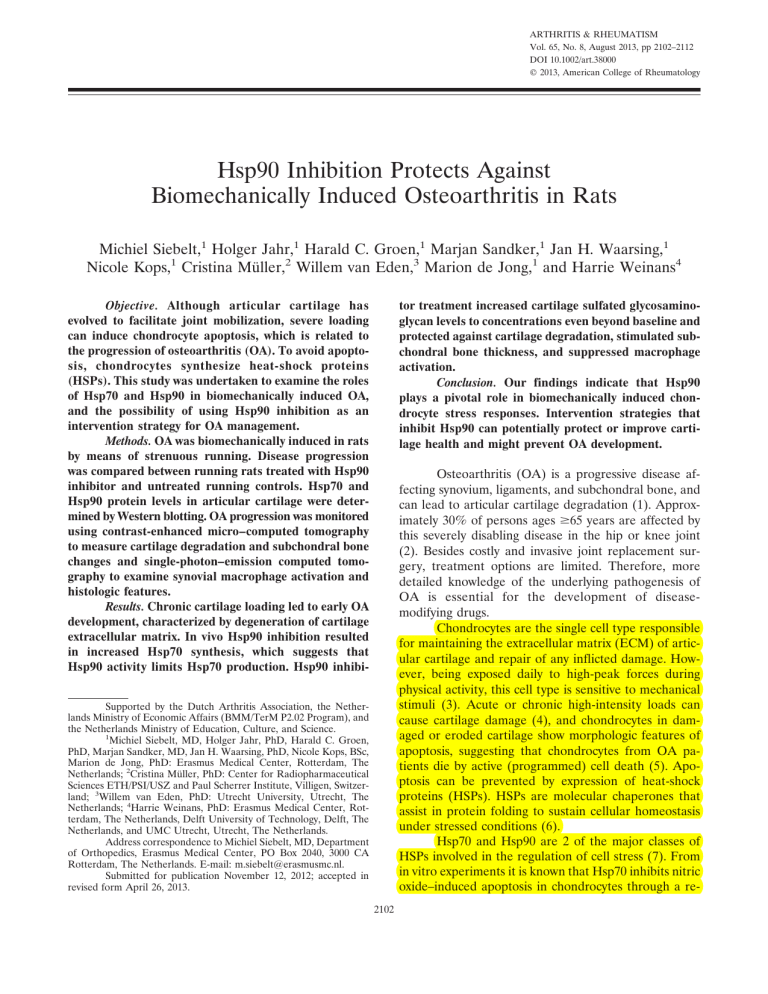
ARTHRITIS & RHEUMATISM Vol. 65, No. 8, August 2013, pp 2102–2112 DOI 10.1002/art.38000 © 2013, American College of Rheumatology Hsp90 Inhibition Protects Against Biomechanically Induced Osteoarthritis in Rats Michiel Siebelt,1 Holger Jahr,1 Harald C. Groen,1 Marjan Sandker,1 Jan H. Waarsing,1 Nicole Kops,1 Cristina Müller,2 Willem van Eden,3 Marion de Jong,1 and Harrie Weinans4 tor treatment increased cartilage sulfated glycosaminoglycan levels to concentrations even beyond baseline and protected against cartilage degradation, stimulated subchondral bone thickness, and suppressed macrophage activation. Conclusion. Our findings indicate that Hsp90 plays a pivotal role in biomechanically induced chondrocyte stress responses. Intervention strategies that inhibit Hsp90 can potentially protect or improve cartilage health and might prevent OA development. Objective. Although articular cartilage has evolved to facilitate joint mobilization, severe loading can induce chondrocyte apoptosis, which is related to the progression of osteoarthritis (OA). To avoid apoptosis, chondrocytes synthesize heat-shock proteins (HSPs). This study was undertaken to examine the roles of Hsp70 and Hsp90 in biomechanically induced OA, and the possibility of using Hsp90 inhibition as an intervention strategy for OA management. Methods. OA was biomechanically induced in rats by means of strenuous running. Disease progression was compared between running rats treated with Hsp90 inhibitor and untreated running controls. Hsp70 and Hsp90 protein levels in articular cartilage were determined by Western blotting. OA progression was monitored using contrast-enhanced micro–computed tomography to measure cartilage degradation and subchondral bone changes and single-photon–emission computed tomography to examine synovial macrophage activation and histologic features. Results. Chronic cartilage loading led to early OA development, characterized by degeneration of cartilage extracellular matrix. In vivo Hsp90 inhibition resulted in increased Hsp70 synthesis, which suggests that Hsp90 activity limits Hsp70 production. Hsp90 inhibi- Osteoarthritis (OA) is a progressive disease affecting synovium, ligaments, and subchondral bone, and can lead to articular cartilage degradation (1). Approximately 30% of persons ages ⱖ65 years are affected by this severely disabling disease in the hip or knee joint (2). Besides costly and invasive joint replacement surgery, treatment options are limited. Therefore, more detailed knowledge of the underlying pathogenesis of OA is essential for the development of diseasemodifying drugs. Chondrocytes are the single cell type responsible for maintaining the extracellular matrix (ECM) of articular cartilage and repair of any inflicted damage. However, being exposed daily to high-peak forces during physical activity, this cell type is sensitive to mechanical stimuli (3). Acute or chronic high-intensity loads can cause cartilage damage (4), and chondrocytes in damaged or eroded cartilage show morphologic features of apoptosis, suggesting that chondrocytes from OA patients die by active (programmed) cell death (5). Apoptosis can be prevented by expression of heat-shock proteins (HSPs). HSPs are molecular chaperones that assist in protein folding to sustain cellular homeostasis under stressed conditions (6). Hsp70 and Hsp90 are 2 of the major classes of HSPs involved in the regulation of cell stress (7). From in vitro experiments it is known that Hsp70 inhibits nitric oxide–induced apoptosis in chondrocytes through a re- Supported by the Dutch Arthritis Association, the Netherlands Ministry of Economic Affairs (BMM/TerM P2.02 Program), and the Netherlands Ministry of Education, Culture, and Science. 1 Michiel Siebelt, MD, Holger Jahr, PhD, Harald C. Groen, PhD, Marjan Sandker, MD, Jan H. Waarsing, PhD, Nicole Kops, BSc, Marion de Jong, PhD: Erasmus Medical Center, Rotterdam, The Netherlands; 2Cristina Müller, PhD: Center for Radiopharmaceutical Sciences ETH/PSI/USZ and Paul Scherrer Institute, Villigen, Switzerland; 3Willem van Eden, PhD: Utrecht University, Utrecht, The Netherlands; 4Harrie Weinans, PhD: Erasmus Medical Center, Rotterdam, The Netherlands, Delft University of Technology, Delft, The Netherlands, and UMC Utrecht, Utrecht, The Netherlands. Address correspondence to Michiel Siebelt, MD, Department of Orthopedics, Erasmus Medical Center, PO Box 2040, 3000 CA Rotterdam, The Netherlands. E-mail: m.siebelt@erasmusmc.nl. Submitted for publication November 12, 2012; accepted in revised form April 26, 2013. 2102 Hsp90 IN OSTEOARTHRITIS 2103 Figure 1. Representation of hypothetical roles of Hsp70 and Hsp90 in osteoarthritis (OA). A, Healthy cartilage. Normal chondrocytes reside in a sulfated glycosaminoglycan (sGAG)–rich extracellular matrix (ECM). Subchondral bone is intact, and supportive, inactive macrophages are present within the synovium. B, Stressed cartilage during strenuous running. A small amount of sGAG is lost from the ECM. Due to loss of cartilage hydrostatic pressure, chondrocytes become biomechanically stressed. In order to cope, chondrocytes up-regulate Hsp70. C, Persisting biomechanical stress. Stressed chondrocytes have diminished biosynthetic capacity and produce less sGAG, and Hsp90 is up-regulated. Activated osteoclasts penetrate the subchondral plate, impairing its supportive function. Macrophages produce proinflammatory cytokines and growth factors. D, OA. Eventually, a vicious circle of events, as described in C, culminates in chondrocytes ultimately dying from apoptosis. The integrity of the ECM is compromised and its biomechanical properties deteriorate. Osteoclasts tunnel their way through the subchondral bone, making space for osteoblast and vascular infiltration, which will eventually lead to the development of a sclerotic bone phenotype. Continuous macrophage cytokine and growth factor production thickens the synovium and results in fibrosis, reducing the patient’s range of motion and causing pain. Color figure can be viewed in the online issue, which is available at http://onlinelibrary.wiley.com/doi/10.1002/art.38000/abstract. duction in caspase 3 activity (8). Galois et al reported similar findings in an in vivo study of rats and showed that mild running (7.5 km in 28 days) and moderate running (15 km in 28 days) stimulated Hsp70 production (9). These schedules protected chondrocytes against caspase 3–induced apoptosis and reduced OA progression. Other studies further support the finding that Hsp70 has the potential to prevent cartilage damage in arthritic joints (10,11). Thus, Hsp70 is thought to play a protective role in early stages of chondrocyte adaptation to biomechanical joint constraints, which otherwise would lead to OA (12). However, intense running (30 km in 28 days) reduced Hsp70 expression back to nonrunning control levels (9) and, therefore, supraphysiologic loading seems to exceed the intrinsic Hsp70mediated capacity for cellular damage control, ultimately still resulting in apoptosis. This corroborates findings that intense or strenuous running protocols are known to induce OA (13,14). It is hypothesized that with persistent stress on cartilage, either increased levels of Hsp70 are insufficient to protect chondrocytes (15), or the coexpression of other HSPs counteract the effect of Hsp70 (9). The second part of this hypothesis could be explained through Hsp90 function. Whereas Hsp70 inhibits NF-B formation, Hsp90 has an antagonistic function and activates the NF-B pathway (6). Although NF-B plays an essential role in normal physiology, inappropriate regulation of NF-B is related to the pathogenesis of both OA and rheumatoid arthritis (RA) (16). In an in vivo model of RA, Hsp90 inhibition reduced the inflammatory response, prevented cartilage damage, and limited bone resorption (17). In addition, Hsp90 may restrict Hsp70 regulation (18) and, therefore, Hsp90 up-regulation in chondrocytes may counteract the beneficial Hsp70-mediated responses and facilitate OA progression. Hsp90 inhibition might positively affect the level of Hsp70 up-regulation necessary and, through this mechanism, promote cartilage health. In summary, Hsp70- and Hsp90-related chondrocyte stress responses might play an important role in biomechanically induced cartilage stress that develops into OA (Figure 1). Increased physical activity in a model of OA induced by strenuous running exposes chondrocytes in healthy cartilage to chronic impact from joint loading (Figure 1A). To cope with this increased load, chondrocytes may up-regulate Hsp70 to promote cell metabolism to sustain the ECM with sufficient sulfated glycosaminoglycan (sGAG) (Figure 1B). However, persisting cartilage stress through strenuous running could stimulate Hsp90 production, which counteracts the positive effects of Hsp70 and thus promotes OA development (loss of sGAG, degradation of ECM, loss of subchondral bone, and activation of macrophages) (Figure 1C). When cartilage ECM is damaged, OA 2104 SIEBELT ET AL progression will further develop and, in time, progress to severe joint degeneration (Figure 1D). The present study investigates the role of Hsp70 and Hsp90 in a rat model of OA induced by strenuous running. We hypothesized that running-induced loading of articular cartilage up-regulates Hsp90 expression in chondrocytes and limits Hsp70 expression, which results in a loss of the Hsp70-mediated protective effect against OA progression in the knee joint. Therefore, inhibition of Hsp90 might reverse the degenerative effects on cartilage after strenuous running in rats. MATERIALS AND METHODS Study design. Thirty-eight 16-week-old male Wistar rats (Charles River Netherlands) were housed at 21°C on a 12-hour light/dark cycle during the experimental period. Male rats were used in this study since estrogen is known to influence both HSP expression (19) and OA development (20). Animals received standard food pellets and water ad libitum. The following 5 groups were formed: a baseline group (n ⫽ 6), 2 control OA groups, 1 that was followed up for 6 weeks (n ⫽ 6) and 1 that was followed up for 12 weeks (n ⫽ 6), and 2 treatment groups (both treated with the Hsp90 inhibitor BIIB021), 1 that was followed up for 6 weeks (n ⫽ 10) and 1 that was followed up for 12 weeks (n ⫽ 10). All rats (except the baseline group) were run on a motorized rodent treadmill (LE-8700; Panlab Harvard Apparatus). In Wistar rats, strenuous running induces the development of OA through chronic mechanical loading of articular cartilage (14). After an initial training week to acclimate rats to the treadmill exercise, rats were run 1 hour per day, 5 days per week (not on weekends). During the first 10 minutes, the rats ran 20 cm/second (0.72 km/hour) to warm up. This was followed by 50 minutes of running at 33.3 cm/second (1.20 km/hour). The pace and duration of this protocol are equal to ⬃50% of a total exhaustion protocol (21). At the end of the 6-week protocol, the rats had completed 30 km of strenuous running, which leads to the development of moderate OA in their knee joints that does not heal spontaneously (13). We measured changes in Hsp70 and Hsp90 levels in rat articular cartilage to characterize chondrocyte stress responses and relate this to OA development. OA is characterized by sGAG loss from cartilage ECM, cartilage ECM loss, bone resorption, and macrophage activation. For each group, at the end of the experiment, an analysis sequence of micro– computed tomography (micro-CT) and micro–single-photon– emission computed tomography used in combination with micro-CT as an anatomic reference (SPECT/CT) was performed to measure changes in these different aspects of OA. This sequence consisted of in vivo 111In–diethylenetriaminepentaacetic acid (DTPA)–folate SPECT/CT to measure macrophage activation, ex vivo equilibrium partitioning of an ionic contrast agent (EPIC) micro-CT to measure bone and cartilaginous tissue changes, Western blot analysis of articular cartilage Hsp90 and Hsp70, and histologic analysis to examine cartilaginous tissue quality. Figure 2 presents a detailed planning scheme of all groups and conducted tests. All animal protocols were ap- Figure 2. Experimental overview indicating analytical time points and methods for each group of animals. Male Wistar rats (age 16 weeks; n ⫽ 38) were divided into 3 groups: a baseline group (n ⫽ 6), 2 untreated groups with osteoarthritis (OA; n ⫽ 12), and 2 groups with OA treated with the oral Hsp90 inhibitor BIIB021 (n ⫽ 20). All rats, with the exception of those in the baseline group, were subjected to a 6-week strenuous running protocol to induce OA (13). One group of untreated rats with OA (n ⫽ 6) and one group of rats with OA treated with Hsp90 inhibitor (n ⫽ 10) underwent a subsequent 6 weeks of rest before analysis. At the end of the experiment, a full analysis sequence was performed, consisting of in vivo measurement of activated macrophages using 111In–diethylenetriaminepentaacetic acid–folate singlephoton–emission computed tomography, ex vivo bone and cartilage analysis using equilibrium partitioning of an ionic contrast agent micro–computed tomography, histologic analysis, and quantification of Hsp70 and Hsp90 levels by Western blotting. proved by the Animal Ethics Committee of Erasmus Medical Center. Hsp90 inhibition via orally administered BIIB021. All animals in both treatment groups were treated orally with the fully synthetic Hsp90 inhibitor BIIB021 (Selleck Chemicals), which competitively binds in the ATP-binding pocket of Hsp90, similar to other geldanamycin-derived Hsp90 inhibitors (22). Previous work has shown that Hsp90 inhibitors do not interfere with Hsp70 functioning (23). BIIB021 was dissolved in DMSO and further diluted in saline to a 0.02% DMSO solution with a BIIB021 concentration of 14 mg/ml. Throughout the entire study, each animal received 0.5 ml of this solution with each dose of BIIB021 via oral probing. High doses of other types of Hsp90 inhibitors (such as geldanamycin derivatives) result in drug-related gastrointestinal, bone marrow, or hepatic toxicities (24). Therefore, each animal received 7 mg of BIIB021 3 times per week, every other day except on weekends, so that cells in the gastrointestinal tract and bone marrow could recover from Hsp90 inhibition. Detection of activated macrophages by SPECT/CT using 111In-DTPA-folate. Activated macrophages express folate receptor , allowing the monitoring of macrophages in vivo using folate radioconjugates (25). This technique was recently introduced for OA research in a rat model (26). Briefly, DTPA-folate (conjugate kindly provided by Professor R. Schibli, Center for Radiopharmaceutical Sciences ETHPSI-USZ, Zurich, Switzerland) was incubated with 111InCl3 (Mallinckrodt-Tyco) in phosphate buffered saline (PBS; pH 6.5) for 1 hour at room temperature. Quality control performed using high-performance liquid chromatography revealed a radiochemical yield of ⬃92% at a specific activity of Hsp90 IN OSTEOARTHRITIS ⬎16 MBq/g. After the addition of a solution of DTPA for complexation of traces of free 111In(III), the solution was further diluted in PBS and administered via the tail vein 20 hours prior to scanning. SPECT/CT scans were performed with a 4-head multiplex multipinhole small animal SPECT/CT camera (NanoSPECT/CT; Bioscan). Each detector head was fitted with a tungsten-based collimator of nine 2.5-mm diameter pinholes, the field of view was 24 mm in width, and energy peaks were set at 170 keV and 240 keV (⫾10%). All rat knee joints were scanned using both helical micro-CT (acquisition time 5 minutes) and SPECT/CT (acquisition time 30 minutes). After scanning, all data sets were reconstructed at an isotropic CT voxel size of 0.2 mm3 and an isotropic SPECT/CT voxel size of 0.6 mm3 using HiSPECT software (Scivis). All scans were analyzed using InVivoScope processing software (Bioscan). A cylindrical region of interest (ROI) was manually determined for quantification of the radioactivity around the knee joint; all data are presented as activity measured per mm3. Measurements of rat bone, cartilage, and growth plate using EPIC micro-CT. OA is characterized by loss of sGAG from the cartilage ECM, followed by cartilage degradation. Cartilage and growth plate x-ray attenuation from contrast (ioxaglate)–enhanced micro-CT scans (EPIC micro-CT) is inversely related to the sGAG content of cartilage (27) and indicative of tissue quality (13). With EPIC micro-CT, it is possible to accurately quantify morphometric parameters of cartilaginous tissue, as well as the subchondral bone (28). Animals were killed immediately after the SPECT/CT scan. Both knee joints were harvested and randomly assigned to EPIC micro-CT or protein analysis by Western blotting. Soft tissue was carefully removed to a maximal extent from all knee joints selected for EPIC micro-CT, without harming cartilage integrity. Next, all specimens were incubated in a 40% solution of ioxaglate for 24 hours at room temperature (29). EPIC micro-CT was performed on a SkyScan 1076 in vivo micro-CT scanner, using the following scan settings: isotropic voxel size 35 m, voltage 55 kV, current 181 mA, field of view 68 mm, with a 0.5-mm aluminum filter, over 198° with a 0.4° rotation step. All scans were performed using the same settings, and all data were reconstructed identically. Using CT analysis software (SkyScan), these data sets were segmented using a fixed attenuation threshold between air (at 25) and subchondral bone (at 100) (13). In all segmented micro-CT data sets, ROIs were drawn around the cartilage of the medial and lateral plateau of the tibia to calculate x-ray attenuation (arbitrary gray values), which is inversely related to sGAG content (cartilage quality), and cartilage thickness (in micrometers). Tibial plateau cartilage was analyzed since it is predominantly affected during OA induced by strenuous exercise (30). Bone was accurately segmented from all EPIC micro-CT data sets using a local threshold algorithm (31). Cortical and trabecular bone were automatically separated using in-house software (32) (details regarding both 3-D calculator software and separation software are available from the corresponding author upon request). Using the CT analysis software (SkyScan), the tibial epiphysis was selected in the segmented CT scans and analyzed for changes in cortical and trabecular bone. Both the medial and lateral thicknesses of the subchondral plate were measured. 2105 Histopathologic examination of the rat knee joint. After EPIC micro-CT, the separated parts of the rat knee joints were fixed in paraformaldehyde, decalcified with formic acid, and embedded in paraffin. Sagittal sections were cut at 300 m intervals and stained with Safranin O to detect the amount and distribution of GAG. All sections were stained in parallel, to minimize staining bias between different samples. The mid-sections of both the medial and lateral tibial plateau were digitized with the NanoZoomer Digital Pathology program (Hamamatsu Photonics). From these digital images, the cartilage was isolated in silico, and the staining intensity was quantified using graphics software (Adobe Photoshop). Cartilage thickness was measured at 7 different locations using NanoZoomer, and the mean thickness was recorded as the average histologic cartilage thickness (33). Additionally, medial and lateral tibial plateau sections were scored according to the OA Research Society International (OARSI) histopathology initiative (34). Protein extraction and Western blotting. From all rat knee joints selected for protein analysis, the articular cartilage (both medial and lateral) of the tibial plateau was harvested, rinsed in physiologic saline, immediately snap-frozen in liquid nitrogen, and stored at ⫺80°C until used. The samples were pulverized for 2 minutes at 30 Hz in a TissueLyser II (Qiagen) using chromium steel grinding balls and custom-made polytetrafluoroethylene vials. Samples were resuspended in lysis buffer (35) and purified as previously described (36). Protein quantification, loading of sodium dodecyl sulfate–polyacrylamide gels, blotting, and signal quantification were performed as previously described (37), and Hsp70 and Hsp90 antigens were detected using the methods described by Xing et al (38) and Hirano et al (39), respectively, using the recommended antibody dilutions. Visualization was performed on an Odyssey infrared imaging system with IRDye 680RD and IRDye 800CW secondary antibodies (1:15,000; both from Li-Cor Biosciences), respectively. Replicate data per animal were averaged and normalized to ␣-tubulin (1:1,000; Cell Signaling Technology) as a loading control. Signal intensities were quantified using ImageJ software (National Institutes of Health). Geldanamycin-like inhibitors that compete for the N-terminal nucleotide-binding pocket interact most potently with the cytoplasmic isoforms Hsp90␣ and Hsp90 (40,41). Both isoforms were measured by Western blotting. BIIB021 interferes with the ATPase activity of Hsp90. However, because this method is unable to distinguish between the activation stages of the HSPs, the data presented represent total HSP content (either inactive or active). Statistical analysis. Differences between mean values for animals in the baseline group and both groups of untreated controls with OA were tested using one-way analysis of variance (ANOVA) with Bonferroni correction (for Western blotting, EPIC micro-CT, and quantitative histologic analysis data) (SPSS). Differences in semiquantitative histology scores between animals in the baseline group and animals in both groups of untreated control rats with OA were analyzed using a Kruskal-Wallis one-way ANOVA. To compare the means of quantitative outcome measurements (Western blotting, EPIC micro-CT, and quantitative histologic analysis) at 6 or at 12 weeks between untreated animals with OA and animals treated with Hsp90 inhibitor, an unpaired t-test was used. A MannWhitney test was used to compare the means of semiquantitative histology scores between untreated controls with OA 2106 SIEBELT ET AL and animals treated with Hsp90 inhibitor. The amount of injected radioactivity per animal can influence DTPA-folate SPECT/CT macrophage measurements. In order to correct for this possible influence when comparing differences between groups, the amount of injected activity was added as a covariable in a linear regression model using SPSS. P values less than 0.05 were considered significant. RESULTS Hsp70 and Hsp90 regulation in OA and Hsp90 inhibition. After a 6-week regimen of running, Hsp90 protein levels were increased 2.1-fold in untreated control rats with OA compared to untreated animals in the baseline group that did not run (Figure 3A). After 6 weeks of subsequent rest, Hsp90 levels in untreated control rats with OA were still higher than those in the baseline group (⬃1.7 fold increase) (Figure 3A). However, neither of these effects were significant (P ⫽ 0.12). Compared to baseline values, Hsp70 levels did not change at 6 weeks or 12 weeks in untreated control rats with OA (P ⫽ 0.55) (Figure 3B). Chondrocytes from animals treated with Hsp90 inhibitor showed a different HSP response to biomechanical stress exposure via running. Compared to untreated control rats with OA, Hsp90 inhibitor–treated Figure 3. Changes in Hsp90 and Hsp70 abundance during chronic loading and after Hsp90 inhibition in articular chondrocytes from rat knee cartilage. A and B, Levels of Hsp90 (A) and Hsp70 (B) in rats that were not subjected to the running protocol (0 weeks), untreated control rats with running-induced osteoarthritis (OA), and rats with running-induced OA treated with Hsp90 inhibitor (Hsp90i). Bars show the mean and 95% confidence interval. ⴱ ⫽ P ⬍ 0.05; ⴱⴱ ⫽ P ⬍ 0.01. C, Representative Western blots of Hsp90 and Hsp70 levels. ␣-tubulin was used as a loading control. animals produced higher amounts of Hsp90 at the end of the running protocol (⬃1.9 fold increase; P ⫽ 0.02), which remained increased after the subsequent 6 weeks of rest (⬃2.2 fold increase; P ⫽ 0.001) (Figure 3A). The increased levels of Hsp90 are consistent with a functional inactivation of Hsp90 by BIIB021, as earlier studies demonstrated a positive feedback regulation of this HSP (22). Further evidence in favor of a functional Hsp90 inactivation can be derived from the subsequent Hsp70 induction (18,22,42), as was observed in the articular cartilage of rats after running (P ⫽ 0.04) (Figure 3B). At week 12, Hsp70 protein levels in Hsp90 inhibitor–treated rats were still increased ⬃2.2 fold compared to nonrunning animals in the baseline group (P ⫽ 0.04), but were not significantly different from the levels in untreated controls with OA (P ⫽ 0.10) (Figure 3B). Representative Western blot images are shown in Figure 3C. Adaptation of cartilaginous tissue. OA is characterized by a loss of sGAG from the cartilage ECM, followed by cartilage degradation. Strenuous running in untreated control rats with OA did not induce clear changes in the articular cartilage of the medial tibial plateau (Figures 4A and B), while at the lateral side, cartilage did show a reduction in ECM thickness (P ⫽ 0.02) (Figure 4D). Hsp90 inhibitor–treated animals had lower attenuation values for both medial plateau (P ⫽ 0.04) (Figure 4A) and lateral plateau (P ⫽ 0.02) cartilage (Figure 4C). This indicates that Hsp90 inhibitor– treated rats had higher levels of sGAG to sustain the cartilage during running. Not only was the sGAG content in both the medial and lateral compartments higher compared to that in the untreated control rats with OA, Hsp90 inhibitor–treated animals even had higher amounts of sGAG compared to healthy animals in the baseline group. After 6 weeks of rest, medial cartilage from the Hsp90 inhibitor–treated animals still had higher sGAG levels (P ⫽ 0.04), while lateral cartilage showed no difference in sGAG content (P ⫽ 0.88) between the Hsp90 inhibitor–treated animals and control animals with OA. However, whereas lateral cartilage from untreated control rats with OA was degraded, Hsp90 inhibitor–treated animals showed no sign of decreased cartilage thickness, and cartilage was thicker compared to that in the control rats with OA (P ⫽ 0.009) (Figure 4D). To further validate these findings, we quantitatively evaluated the sGAG content of cartilage and cartilage thickness in histologic sections. These measurements showed similar patterns between untreated control rats with OA and Hsp90 inhibitor–treated animals and confirmed our EPIC micro-CT results (Figures Hsp90 IN OSTEOARTHRITIS 2107 Figure 4. Differences in cartilaginous tissue between untreated control rats with osteoarthritis (OA) and rats with OA treated with Hsp90 inhibitor. A–J, Examination of cartilage and the epiphyseal growth plate using equilibrium partitioning of an ionic contrast agent (EPIC) micro–computed tomography (micro-CT) (A–E) and histologic analysis (F–J). Both techniques were used to measure the amount of sulfated glycosaminoglycans (sGAG) and cartilage extracellular matrix (ECM) thickness. Attenuation values from EPIC micro-CT scans were inversely related to sGAG content. Bars show the mean and 95% confidence interval. ⴱ ⫽ P ⬍ 0.05; ⴱⴱ ⫽ P ⬍ 0.01; ⴱⴱⴱ ⫽ P ⬍ 0.001. K, Representative images of Safranin O–stained sections of rat medial and lateral tibial plateau cartilage and the medial and lateral growth plate at baseline, after 6 weeks of running, and after a subsequent 6 weeks of rest. Cartilage and growth plate showed loss of sGAG at 6 weeks in untreated animals. In contrast, increased sGAG content was observed in Hsp90 inhibitor–treated animals. At 12 weeks, cartilage damage was evident in untreated animals. Arrows indicate matrix damage. Cartilage damage was less severe in Hsp90 inhibitor (Hsp90i)–treated animals. During the 6 weeks of rest, sGAG content was restored in the growth plates of untreated animals. Insets show the complete histologic sections of the proximal tibia from which the detailed sections of cartilage and growth plate were isolated. L and M, Cartilage damage, as measured by the OA Research Society International (OARSI) score, in the medial plateau (L) and lateral plateau (M) in untreated and Hsp90 inhibitor–treated animals. Data are shown as box plots, where the boxes represent the 25th to 75th percentiles, the lines within the boxes represent the median, and the lines outside the boxes represent the maximum and minimum values. Symbols inside the boxes represent the mean. ⴱ ⫽ P ⬍ 0.05; ⴱⴱ ⫽ P ⬍ 0.01. Color figure can be viewed in the online issue, which is available at http://onlinelibrary.wiley.com/doi/10.1002/art.38000/abstract. 2108 Figure 5. Subchondral bone thickness (sub. chond. plate th.), as measured by micro–computed tomography (micro-CT), of the medial plateau (A) and lateral plateau (B) in rats that were not subjected to the running protocol (0 weeks), in untreated control rats with runninginduced osteoarthritis (OA), and in rats with running-induced OA treated with Hsp90 inhibitor. Bars show the mean and 95% confidence interval. ⴱ ⫽ P ⬍ 0.05. 4F–I). Additional semiquantitative scores according to the OARSI histopathology initiative showed increased medial (P ⫽ 0.002) and lateral (P ⫽ 0.012) cartilage degeneration in untreated controls with OA. In contrast, Hsp90 inhibitor–treated animals showed less cartilage degeneration in both anatomic regions (Figures 4L–M). Representative histology images of cartilage are shown in Figure 4K. The growth plate is a cartilaginous tissue in which bone is formed via endochondral ossification. In rats, the SIEBELT ET AL growth plate never closes and remains highly chondral throughout their lifespan. Increased activity through treadmill running showed that the growth plate is sensitive to high impact from joint loading. EPIC micro-CT and histology revealed that, after strenuous running, the growth plate was severely depleted of sGAG (Figures 4E and J). However, Hsp90 inhibition prevented this sGAG loss. Representative histology images of the growth plate are shown in Figure 4K. Subchondral bone changes. OA is also characterized by periarticular bone changes, which we evaluated with EPIC micro-CT scans. In untreated rats with OA, the medial subchondral plate thickness slowly increased during the study (⬃10% increase after 12 weeks, P ⫽ 0.007). Hsp90 inhibitor–treated animals showed a faster response. Their subchondral bone was already thicker than that of untreated control rats with OA at 6 weeks (P ⫽ 0.04) (Figure 5A). This increase did not progress over time, and Hsp90 inhibitor–treated animals had a similar subchondral bone thickness compared to untreated controls with OA at 12 weeks. At this time point, the lateral subchondral bone of untreated controls with OA showed a different response and was ⬃7% thinner than that of Hsp90 inhibitor–treated animals (P ⫽ 0.04) (Figure 5B). Macrophage activation. OA-related macrophage activation was measured in vivo with 111In-DTPA-folate SPECT/CT. Animals in all groups received a mean ⫾ SD of 82 ⫾ 5 MBq of 111In-DTPA-folate. Relative to animals in the baseline group, there was only a slight trend in macrophage activation in untreated control Figure 6. Macrophage activation determined using single-photon–emission computed tomography (SPECT/CT) 20 hours after injection of 111 In–diethylenetriaminepentaacetic acid–folate (111In-DPTA-Fa) into the rat tail vein. A, Measured radioactivity in the knee joints of untreated rats with osteoarthritis (OA) and rats with OA treated with Hsp90 inhibitor. Measurements were corrected for analyzed volume (mm3). High radioactivity is related to greater macrophage activation. Bars show the mean and 95% confidence interval. ⴱⴱ ⫽ P ⬍ 0.01. B, Sagittal SPECT/CT images of knee joints from representative animals in each experimental group. CT images are shown in black and white and were used for anatomic reference; SPECT/CT images are shown in color. Hsp90 IN OSTEOARTHRITIS animals with OA after 6 weeks of running (P ⫽ 0.1). The amount of activated macrophages present in Hsp90 inhibitor–treated animals after 6 weeks of strenuous running was significantly lower than in untreated control rats with OA (P ⫽ 0.008) (Figure 6). In Hsp90 inhibitor– treated animals, macrophage activation levels showed a clear increase from 6 to 12 weeks (P ⬍ 0.0001). DISCUSSION HSPs evolved to protect cells against physiologic stress. Hsp90 directly promotes cell survival through formation of active NF-B (6), indirectly promotes cell survival via Hsp90–Akt complexes that inhibit JNKmediated cell death through phosphorylation and consequent inactivation of apoptosis signal–regulating kinase 1 (43), modulates the intrinsic pathway of apoptosis by inhibiting oligomerization of Apaf-1 (44), and influences glucocorticoid receptor, shaping cellular responses to glucocorticoids (45). However, this system may become overwhelmed under high-end stresses, and then tissue homeostasis is lost (46). In the present study, we used strenuous running as an established method to induce a mild OA phenotype in rats (13) (Figure 4). Running caused a trend toward Hsp90 accumulation in cartilage that did not decline and remained elevated during 6 weeks of rest, while Hsp70 levels remained unaltered (Figure 3). Interestingly, it is known that during a subsequent period of rest after strenuous exercise, OA continues to progress, lacking spontaneous cartilage repair (13). In contrast to previous reports of increased Hsp70 levels after 28 days of exercise (9), we measured Hsp70 and Hsp90 only after 42 and 84 days. Due to analysis at these limited time points, we are unable to conclude what specific mechanism leads to the changes in Hsp70 and Hsp90 levels. To identify strenuous running as an HSP inducer, more studies are needed that focus on earlier time points, and additional samples should be analyzed immediately after running and after several hours of rest. In this model, we used BIIB021 treatment to evaluate potential OA-modifying aspects of pharmacologic Hsp90 inhibition. Systemically introduced Hsp90 inhibition may be toxic (24). However, our treatment regimen did not result in weight or hair loss in the treated animals, which might have suggested Hsp90 inhibition–related toxicity. Hsp90 inhibition resulted in elevated Hsp90 protein levels as well as higher Hsp70 levels. Previous work with BIIB021 and other Hsp90 inhibitors clearly demonstrated a concentration-dependent effect of Hsp90 inhibition on the induction of both Hsp90 and Hsp70. 2109 Although elevation of Hsp90 levels seems to be a counterintuitive result of Hsp90 inhibition, it is a wellknown response to different Hsp90 inhibitors, such as geldanamycin, 17-allylamino-17-demethoxygeldanamycin, and BIIB021. Through binding in the ATP-binding pocket of Hsp90, they prevent activation of Hsp90, which results in reduced Hsp90 activity with degradation of downstream client proteins, such as human epidermal growth factor receptor 2, AKT, and Raf-1 (22,47). Functional inactivation of Hsp90 by BIIB021 also induces Hsp70, which can be explained by the role of heat-shock factor 1 (HSF-1). HSF-1 plays an established role in the regulation of Hsp70 levels. It is kept in a latent state by a stress–protein complex and is activated upon proteotoxic insults (overloading) in order to activate Hsp70 gene expression (48). Hsp90 is a major repressor of HSF-1 gene expression and retains HSF-1 in an inactive nontrimeric state (49). When mechanical loading increases, Hsp90 production is increased, which reduces HSF-1 activity, and Hsp70 up-regulation is prevented. This inverse regulation of Hsp70 and Hsp90 through HSF-1 may explain why Hsp70 is known to be less responsive to increased loads (50) and why the protective effect of Hsp70 for maintaining ECM homeostasis and cartilage protection is compromised in our running-induced model of OA. In the present study, Hsp90 inhibitor–treated animals showed increased Hsp70 protein levels. As one would expect, Hsp90 inhibition strongly induces HSF-1 in human chondrocytes (51). This explains why diminished Hsp90 activity shifts the balance in favor of Hsp70 synthesis (18,22,42) and stimulates the Hsp70 protective effect on cartilage. It is due to this feedback loop that Hsp70 is used as a standard pharmacodynamic biomarker for the analysis of Hsp90 inhibitors functioning in both preclinical and clinical studies (52). However, Hsp90 inhibition can also directly influence cellular processes that reduce OA progression. Hsp90 inhibition of in vitro–cultured human articular chondrocytes selectively inhibited interleukin-1–induced ERK activation and resulted in reduced matrix metalloproteinase 13 (MMP-13) production (53). Since excessive MMP-13 activity results in articular cartilage degradation, reduced MMP-13 production might prevent OA (54). The findings of the present study do not allow us to establish whether Hsp90 inhibition reduced OA progression directly or indirectly via increased levels of Hsp70. However, the final outcome of Hsp90 inhibition was marked changes in cartilage degradation, subchondral bone remodeling, and synovial macrophage activation. In the present study, articular cartilage from 2110 Hsp90 inhibitor–treated animals had higher amounts of sGAG (Figure 4), which probably gives cartilage the necessary hydrostatic stiffness to absorb impact during running and to protect chondrocytes against increased mechanical stress. Hsp90 inhibitor treatment also resulted in a more prompt increase in medial subchondral bone thickness compared to untreated control rats with OA, and Hsp90 inhibition prevented subchondral bone plate thinning in the lateral compartment (Figure 5). Strenuous running did not induce macrophage activation in untreated animals. Nevertheless, animals treated with Hsp90 inhibitor did show reduced levels of macrophage activation after 6 weeks of running (Figure 6). However, despite continuous Hsp90 inhibitor treatment, macrophage activation increased again during the subsequent 6 weeks of rest (Figure 6) and may suggest that Hsp90 inhibitor did not directly modulate macrophage responses. A direct translation of our results into a clinical treatment for OA patients may not be possible. BIIB021 and other geldanamycin-derived Hsp90 inhibitors are currently used in cancer trials. Treatment of lifethreatening diseases might justify higher risks of Hsp90associated dose-limiting toxicities (24), but can never be accepted in OA patients. Therefore, more detailed knowledge of the downstream targets that are modulated by Hsp90 inhibition is needed. Another way to reduce systemic side effects is to investigate whether local treatment via intraarticular injections with Hsp90 inhibitor is feasible and beneficial. Hyaline articular cartilage evolved to absorb forces that develop during joint mobilization. From this perspective, a balance can be expected between biomechanical loads and chondrocyte functioning, and an imbalance is likely to result in cartilage failure and OA development. When stress on cartilage is increased, either via increased loading or due to changed joint biomechanics (e.g., as a result of ligament tears) (9), chondrocytes up-regulate HSPs, which suggests a pivotal role in OA onset. However, few studies report HSP production by chondrocytes as a possible regulator of cartilage homeostasis under stressed conditions. More research on this topic will lead to a more accurate explanatory model for pathologic joint loading–induced OA. Ambivalent effects of training on cartilage are well known in clinical patient care (55). A combined approach of regulated physical exercise and therapeutic intervention of HSP production might reduce stress exposure of chondrocytes in OA patients. The results of our in vivo study strongly suggest that chondrocyte stress-induced Hsp90 synthesis plays an important role in the onset of OA. Biomechanical SIEBELT ET AL stress induced by strenuous running tended to increase Hsp90 protein levels in rat articular cartilage. Hsp90 inhibition and the subsequently increased Hsp70 levels enabled chondrocytes to maintain cartilage homeostasis by increasing sGAG amounts above baseline in order to protect the ECM from increasing biomechanical impact during physical activity. Hsp90 inhibition further improved subchondral bone thickness and reduced synovial macrophage activation. Specific modulation of chondrocyte Hsp90 activity might prove to be an attractive therapeutic intervention to prevent OA. AUTHOR CONTRIBUTIONS All authors were involved in drafting the article or revising it critically for important intellectual content, and all authors approved the final version to be published. Dr. Siebelt had full access to all of the data in the study and takes responsibility for the integrity of the data and the accuracy of the data analysis. Study conception and design. Siebelt, Jahr, Groen, Sandker, Waarsing, Kops, Müller, van Eden, de Jong, Weinans. Acquisition of data. Siebelt, Jahr, Groen, Sandker, Waarsing, Kops, Müller, van Eden, de Jong, Weinans. Analysis and interpretation of data. Siebelt, Jahr, Groen, Sandker, Waarsing, Kops, Müller, van Eden, de Jong, Weinans. REFERENCES 1. Mankin HJ, Dorfman H, Lippiello L, Zarins A. Biochemical and metabolic abnormalities in articular cartilage from osteo-arthritic human hips. II. Correlation of morphology with biochemical and metabolic data. J Bone Joint Surg Am 1971;53:523–37. 2. Odding E, Valkenburg HA, Stam HJ, Hofman A. Determinants of locomotor disability in people aged 55 years and over: the Rotterdam Study. Eur J Epidemiol 2001;17:1033–41. 3. Sun HB. Mechanical loading, cartilage degradation, and arthritis. Ann N Y Acad Sci 2010;1211:37–50. 4. Saxon L, Finch C, Bass S. Sports participation, sports injuries and osteoarthritis: implications for prevention. Sports Med 1999;28: 123–35. 5. Blanco FJ, Guitian R, Vazquez-Martul E, de Toro FJ, Galdo F. Osteoarthritis chondrocytes die by apoptosis: a possible pathway for osteoarthritis pathology. Arthritis Rheum 1998;41:284–9. 6. Arya R, Mallik M, Lakhotia SC. Heat shock genes—integrating cell survival and death. J Biosci 2007;32:595–610. 7. Samali A, Orrenius S. Heat shock proteins: regulators of stress response and apoptosis. Cell Stress Chaperones 1998;3:228–36. 8. Terauchi R, Takahashi KA, Arai Y, Ikeda T, Ohashi S, Imanishi J, et al. Hsp70 prevents nitric oxide–induced apoptosis in articular chondrocytes. Arthritis Rheum 2003;48:1562–8. 9. Galois L, Etienne S, Grossin L, Watrin-Pinzano A, CournilHenrionnet C, Loeuille D, et al. Dose–response relationship for exercise on severity of experimental osteoarthritis in rats: a pilot study. Osteoarthritis Cartilage 2004;12:779–86. 10. Etienne S, Gaborit N, Henrionnet C, Pinzano A, Galois L, Netter P, et al. Local induction of heat shock protein 70 (Hsp70) by proteasome inhibition confers chondroprotection during surgically induced osteoarthritis in the rat knee. Biomed Mater Eng 2008; 18:253–60. 11. Grossin L, Etienne S, Gaborit N, Pinzano A, Cournil-Henrionnet C, Gerard C, et al. Induction of heat shock protein 70 (Hsp70) by proteasome inhibitor MG 132 protects articular chondrocytes from cellular death in vitro and in vivo. Biorheology 2004;41:521–34. 12. Takahashi K, Kubo T, Goomer RS, Amiel D, Kobayashi K, Hsp90 IN OSTEOARTHRITIS 13. 14. 15. 16. 17. 18. 19. 20. 21. 22. 23. 24. 25. 26. 27. 28. 29. Imanishi J, et al. Analysis of heat shock proteins and cytokines expressed during early stages of osteoarthritis in a mouse model. Osteoarthritis Cartilage 1997;5:321–9. Siebelt M, Waarsing JH, Kops N, Piscaer TM, Verhaar JA, Oei EH, et al. Quantifying osteoarthritic cartilage changes accurately using in vivo microCT arthrography in three etiologically distinct rat models. J Orthop Res 2011;29:1788–94. Pap G, Eberhardt R, Sturmer I, Machner A, Schwarzberg H, Roessner A, et al. Development of osteoarthritis in the knee joints of Wistar rats after strenuous running exercise in a running wheel by intracranial self-stimulation. Pathol Res Pract 1998;194:41–7. Takahashi KA, Tonomura H, Arai Y, Terauchi R, Honjo K, Hiraoka N, et al. Hyperthermia for the treatment of articular cartilage with osteoarthritis. Int J Hyperthermia 2009;25:661–7. Roman-Blas JA, Jimenez SA. NF-B as a potential therapeutic target in osteoarthritis and rheumatoid arthritis. Osteoarthritis Cartilage 2006;14:839–48. Rice JW, Veal JM, Fadden RP, Barabasz AF, Partridge JM, Barta TE, et al. Small molecule inhibitors of Hsp90 potently affect inflammatory disease pathways and exhibit activity in models of rheumatoid arthritis. Arthritis Rheum 2008;58:3765–75. Clarke PA, Hostein I, Banerji U, Di Stefano F, Maloney A, Walton M, et al. Gene expression profiling of human colon cancer cells following inhibition of signal transduction by 17-allylamino17-demethoxygeldanamycin, an inhibitor of the hsp90 molecular chaperone. Oncogene 2000;19:4125–33. Hamilton KL, Gupta S, Knowlton AA. Estrogen and regulation of heat shock protein expression in female cardiomyocytes: cross-talk with NFB signaling. J Mol Cell Cardiol 2004;36:577–84. Roman-Blas JA, Castaneda S, Largo R, Herrero-Beaumont G. Osteoarthritis associated with estrogen deficiency. Arthritis Res Ther 2009;11:241. Tarini VA, Carnevali LC Jr, Arida RM, Cunha CA, Alves ES, Seeleander MC, et al. Effect of exhaustive ultra-endurance exercise in muscular glycogen and both Alpha1 and Alpha2 AMPK protein expression in trained rats. J Physiol Biochem 2012. E-pub ahead of print. Lundgren K, Zhang H, Brekken J, Huser N, Powell RE, Timple N, et al. BIIB021, an orally available, fully synthetic small-molecule inhibitor of the heat shock protein Hsp90. Mol Cancer Ther 2009;8:921–9. Yun CH, Yoon SY, Nguyen TT, Cho HY, Kim TH, Kim ST, et al. Geldanamycin inhibits TGF- signaling through induction of Hsp70. Arch Biochem Biophys 2010;495:8–13. Glaze ER, Lambert AL, Smith AC, Page JG, Johnson WD, McCormick DL, et al. Preclinical toxicity of a geldanamycin analog, 17-(dimethylaminoethylamino)-17-demethoxygeldanamycin (17-DMAG), in rats and dogs: potential clinical relevance. Cancer Chemother Pharmacol 2005;56:637–47. Turk MJ, Breur GJ, Widmer WR, Paulos CM, Xu LC, Grote LA, et al. Folate-targeted imaging of activated macrophages in rats with adjuvant-induced arthritis. Arthritis Rheum 2002;46:1947–55. Piscaer TM, Muller C, Mindt TL, Lubberts E, Verhaar JA, Krenning EP, et al. Imaging of activated macrophages in experimental osteoarthritis using folate-targeted animal singlephoton–emission computed tomography/computed tomography. Arthritis Rheum 2011;63:1898–907. Palmer AW, Guldberg RE, Levenston ME. Analysis of cartilage matrix fixed charge density and three-dimensional morphology via contrast-enhanced microcomputed tomography. Proc Natl Acad Sci U S A 2006;103:19255–60. Aula AS, Jurvelin JS, Toyras J. Simultaneous computed tomography of articular cartilage and subchondral bone. Osteoarthritis Cartilage 2009;17:1583–8. Silvast TS, Jurvelin JS, Lammi MJ, Toyras J. pQCT study on diffusion and equilibrium distribution of iodinated anionic contrast agent in human articular cartilage—associations to matrix composition and integrity. Osteoarthritis Cartilage 2009;17:26–32. 2111 30. Beckett J, Jin W, Schultz M, Chen A, Tolbert D, Moed BR, et al. Excessive running induces cartilage degeneration in knee joints and alters gait of rats. J Orthop Res 2012;30:1604–10. 31. Waarsing JH, Day JS, Weinans H. An improved segmentation method for in vivo microCT imaging. J Bone Miner Res 2004;19: 1640–50. 32. Botter SM, van Osch GJ, Clockaerts S, Waarsing JH, Weinans H, van Leeuwen JP. Osteoarthritis induction leads to early and temporal subchondral plate porosity in the tibial plateau of mice: an in vivo microfocal computed tomography study. Arthritis Rheum 2011;63:2690–9. 33. Pastoureau P, Leduc S, Chomel A, De Ceuninck F. Quantitative assessment of articular cartilage and subchondral bone histology in the meniscectomized guinea pig model of osteoarthritis. Osteoarthritis Cartilage 2003;11:412–23. 34. Gerwin N, Bendele AM, Glasson S, Carlson CS. The OARSI Histopathology Initiative—recommendations for histological assessments of osteoarthritis in the rat. Osteoarthritis Cartilage 2010;18 Suppl 3:S24–34. 35. Boehm AK, Seth M, Mayr KG, Fortier LA. Hsp90 mediates insulin-like growth factor 1 and interleukin-1 signaling in an age-dependent manner in equine articular chondrocytes. Arthritis Rheum 2007;56:2335–43. 36. Wilson R, Belluoccio D, Bateman JF. Proteomic analysis of cartilage proteins. Methods 2008;45:22–31. 37. Van der Windt AE, Haak E, Das RH, Kops N, Welting TJ, Caron MM, et al. Physiological tonicity improves human chondrogenic marker expression through nuclear factor of activated T-cells 5 in vitro. Arthritis Res Ther 2010;12:R100. 38. Xing H, Mayhew CN, Cullen KE, Park-Sarge OK, Sarge KD. HSF1 modulation of Hsp70 mRNA polyadenylation via interaction with symplekin. J Biol Chem 2004;279:10551–5. 39. Hirano M, Shibato J, Rakwal R, Kouyama N, Katayama Y, Hayashi M, et al. Transcriptomic analysis of rat brain tissue following gamma knife surgery: early and distinct bilateral effects in the un-irradiated striatum. Mol Cells 2009;27:263–8. 40. Guo W, Siegel D, Ross D. Stability of the Hsp90 inhibitor 17AAG hydroquinone and prevention of metal-catalyzed oxidation. J Pharm Sci 2008;97:5147–57. 41. Soroka J, Buchner J. Mechanistic aspects of the Hsp90 phosphoregulation. Cell Cycle 2012;11:1870–1. 42. Whitesell L, Bagatell R, Falsey R. The stress response: implications for the clinical development of Hsp90 inhibitors. Curr Cancer Drug Targets 2003;3:349–58. 43. Zhang R, Luo D, Miao R, Bai L, Ge Q, Sessa WC, et al. Hsp90-Akt phosphorylates ASK1 and inhibits ASK1-mediated apoptosis. Oncogene 2005;24:3954–63. 44. Pandey P, Saleh A, Nakazawa A, Kumar S, Srinivasula SM, Kumar V, et al. Negative regulation of cytochrome c-mediated oligomerization of Apaf-1 and activation of procaspase-9 by heat shock protein 90. EMBO J 2000;19:4310–22. 45. Grad I, Picard D. The glucocorticoid responses are shaped by molecular chaperones. Mol Cell Endocrinol 2007;275:2–12. 46. Proctor CJ, Lorimer IA. Modelling the role of the Hsp70/Hsp90 system in the maintenance of protein homeostasis. PLoS One 2011;6:e22038. 47. Solit DB, Zheng FF, Drobnjak M, Munster PN, Higgins B, Verbel D, et al. 17-allylamino-17-demethoxygeldanamycin induces the degradation of androgen receptor and HER-2/neu and inhibits the growth of prostate cancer xenografts. Clin Cancer Res 2002;8: 986–93. 48. Shamovsky I, Nudler E. New insights into the mechanism of heat shock response activation. Cell Mol Life Sci 2008;65:855–61. 49. Zou J, Guo Y, Guettouche T, Smith DF, Voellmy R. Repression of heat shock transcription factor HSF1 activation by HSP90 (HSP90 complex) that forms a stress-sensitive complex with HSF1. Cell 1998;94:471–80. 50. Kaarniranta K, Holmberg CI, Lammi MJ, Eriksson JE, Sistonen L, 2112 CLINICAL IMAGES Helminen HJ. Primary chondrocytes resist hydrostatic pressureinduced stress while primary synovial cells and fibroblasts show modified Hsp70 response. Osteoarthritis Cartilage 2001;9:7–13. 51. Kimura H, Yukitake H, Tajima Y, Suzuki H, Chikatsu T, Morimoto S, et al. ITZ-1, a client-selective Hsp90 inhibitor, efficiently induces heat shock factor 1 activation. Chem Biol 2010;17:18–27. 52. Dakappagari N, Neely L, Tangri S, Lundgren K, Hipolito L, Estrellado A, et al. An investigation into the potential use of serum Hsp70 as a novel tumour biomarker for Hsp90 inhibitors. Biomarkers 2010;15:31–8. 53. Kimura H, Yukitake H, Suzuki H, Tajima Y, Gomaibashi K, Morimoto S, et al. The chondroprotective agent ITZ-1 inhibits interleukin-1–induced matrix metalloproteinase–13 production and suppresses nitric oxide–induced chondrocyte death. J Pharmacol Sci 2009;110:201–11. 54. Neuhold LA, Killar L, Zhao W, Sung ML, Warner L, Kulik J, et al. Postnatal expression in hyaline cartilage of constitutively active human collagenase-3 (MMP-13) induces osteoarthritis in mice. J Clin Invest 2001;107:35–44. 55. Felson DT, Zhang Y. An update on the epidemiology of knee and hip osteoarthritis with a view to prevention [review]. Arthritis Rheum 1998;41:1343–55. DOI 10.1002/art.38019 © 2013 American College of Rheumatology Clinical Images: Hypercalcemia and miliary sarcoidosis in a 15-year-old boy The patient, a 15-year-old boy, presented with a 3-month history of nausea, vomiting, fatigue, and worsening headache. Results of physical examination were notable for enlargement of occipital, cervical, axillary, and inguinal lymph nodes, mild hypertension, and scattered hypopigmented plaques over the posterior neck and extensor surfaces of multiple joints. Initial laboratory tests revealed the following values: serum creatinine 2.2 mg/dl, serum calcium 12.9 mg/dl, and ionized calcium 1.74 mmoles/liter. Abdominal ultrasound demonstrated retroperitoneal lymphadenopathy and medullary nephrocalcinosis. Radiographs of the chest (A) showed a subtle interstitial prominence, without evidence of hilar adenopathy. Diffuse miliary interstitial nodules throughout the lung parenchyma were seen on computed tomography of the chest (B). Results of pulmonary function tests were within normal limits. Additional laboratory studies showed undetectable levels of parathyroid hormone (PTH) (⬍3 pg/ml) and PTH-related peptide (⬍2 pmoles/liter), low 25-hydroxyvitamin D levels (18 ng/ml), and elevated serum lysozyme levels (28 g/ml). Levels of angiotensinconverting enzyme and 1,25-hydroxyvitamin D were within normal limits. The patient underwent transbronchial lung biopsy (C) and lymph node biopsy (D), which revealed multiple noncaseating epithelioid granulomas (arrows) and prominent areas of hyalinization (arrowheads). No evidence of mycobacterial or fungal infections was found on serologic tests, histologic stains, or tissue culture. Sarcoidosis was diagnosed, and initiation of corticosteroid therapy resulted in rapid resolution of hypercalcemia and improvement of the serum creatinine level within 1 week. Complete resolution of lymphadenopathy was seen after 4 months. To our knowledge, this is the first description of miliary sarcoidosis in a pediatric patient. Holly K. Hodges, MD Pui Y. Lee, MD, PhD Jonathan S. Hausmann, MD Lisa A. Teot, MD Ethan L. Sanford, MD Kathleen W. Levin, MD Boston Children’s Hospital Boston, MA
